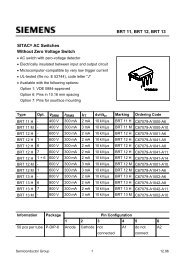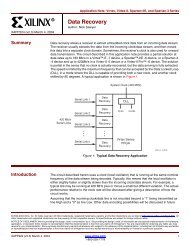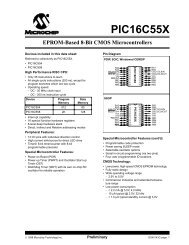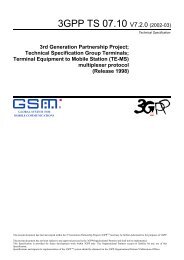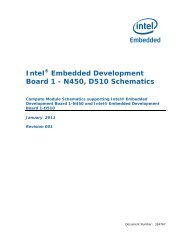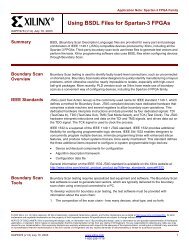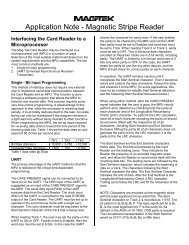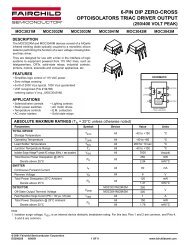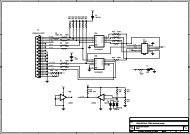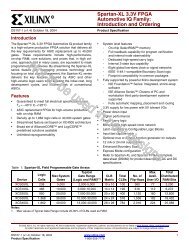XTR103 4-20mA Current Transmitter with RTD EXCITATION AND ...
XTR103 4-20mA Current Transmitter with RTD EXCITATION AND ...
XTR103 4-20mA Current Transmitter with RTD EXCITATION AND ...
- No tags were found...
Create successful ePaper yourself
Turn your PDF publications into a flip-book with our unique Google optimized e-Paper software.
®<br />
<strong>XTR103</strong><br />
4-<strong>20mA</strong> <strong>Current</strong> <strong>Transmitter</strong> <strong>with</strong><br />
<strong>RTD</strong> <strong>EXCITATION</strong> <strong>AND</strong> LINEARIZATION<br />
FEATURES<br />
● LESS THAN ±1% TOTAL ADJUSTED<br />
ERROR, –40°C TO +85°C<br />
● <strong>RTD</strong> <strong>EXCITATION</strong> <strong>AND</strong> LINEARIZATION<br />
● TWO OR THREE-WIRE <strong>RTD</strong> OPERATION<br />
● WIDE SUPPLY RANGE: 9V to 40V<br />
● HIGH PSR: 110dB min<br />
● HIGH CMR: 80dB min<br />
DESCRIPTION<br />
The <strong>XTR103</strong> is a monolithic 4-<strong>20mA</strong>, two-wire<br />
current transmitter designed for Platinum <strong>RTD</strong> temperature<br />
sensors. It provides complete <strong>RTD</strong> current<br />
excitation, instrumentation amplifier, linearization, and<br />
current output circuitry on a single integrated circuit.<br />
Versatile linearization circuitry provides a 2nd-order<br />
correction to the <strong>RTD</strong>, typically achieving a 40:1<br />
improvement in linearity.<br />
Instrumentation amplifier gain can be configured for a<br />
wide range of temperature measurements. Total<br />
adjusted error of the complete current transmitter,<br />
including the linearized <strong>RTD</strong> is less than ±1% over the<br />
full –40 to +85°C operating temperature range. This<br />
includes zero drift, span drift and nonlinearity. The<br />
<strong>XTR103</strong> operates on loop power supply voltages down<br />
to 9V.<br />
The <strong>XTR103</strong> is available in 16-pin plastic DIP and<br />
SOL-16 surface-mount packages specified for the<br />
–40°C to +85°C temperature range.<br />
Nonlinearity (%)<br />
APPLICATIONS<br />
● INDUSTRIAL PROCESS CONTROL<br />
● FACTORY AUTOMATION<br />
● SCADA<br />
5<br />
4<br />
3<br />
2<br />
1<br />
0<br />
–1<br />
–200°C<br />
Pt100 NONLINEARITY CORRECTION<br />
USING <strong>XTR103</strong><br />
Uncorrected<br />
<strong>RTD</strong> Nonlinearity<br />
Corrected<br />
Nonlinearity<br />
Process Temperature (°C)<br />
I R = 0.8mA<br />
I R = 0.8mA<br />
R G<br />
+<br />
<strong>XTR103</strong><br />
9 to 40V<br />
4-20 mA<br />
+850°C<br />
V PS<br />
V O<br />
<strong>RTD</strong><br />
R L<br />
–<br />
R LIN<br />
International Airport Industrial Park • Mailing Address: PO Box 11400 • Tucson, AZ 85734 • Street Address: 6730 S. Tucson Blvd. • Tucson, AZ 85706<br />
Tel: (520) 746-1111 • Twx: 910-952-1111 • Cable: BBRCORP • Telex: 066-6491 • FAX: (520) 889-1510 • Immediate Product Info: (800) 548-6132<br />
© 1992 Burr-Brown Corporation PDS-1145D Printed in U.S.A. October, 1993
T A = +25°C, V+ = 24V, and 2N6121 external transistor, unless otherwise noted. <strong>XTR103</strong>BP/BU <strong>XTR103</strong>AP/AU<br />
SPECIFICATIONS<br />
ELECTRICAL<br />
PARAMETER CONDITIONS MIN TYP MAX MIN TYP MAX UNITS<br />
OUTPUT<br />
Output <strong>Current</strong> Equation<br />
I O<br />
= V IN<br />
• (0.016 + 40/R G<br />
) + 4mA, V IN<br />
in Volts, R G<br />
in Ω<br />
A<br />
Total Adjusted Error (1) T MIN to T MAX ±1 ±2 % of FS<br />
Output <strong>Current</strong>, Specified Range 4 20 * * mA<br />
Over-Scale Limit 34 40 * * mA<br />
Under Scale-Limit 3.6 3.8 * * mA<br />
Full Scale Output Error V IN = 1V, R G = ∞ ±15 ±50 * ±100 µA<br />
Noise: 0.1Hz to 1kHz R G = 40Ω 8 * µAp-p<br />
ZERO OUTPUT (2) V IN = 0, R G = ∞ 4 * mA<br />
Initial Error ±5 ±50 * ±100 µA<br />
vs Temperature ±0.2 ±0.5 * ±1 µA/°C<br />
vs Supply Voltage, V+ V+ = 9V to 40V (3) 0.5 2 * * µA/V<br />
vs Common-Mode Voltage V CM = 2V to 4V (3) 0.1 2 * * µA/V<br />
SPAN<br />
Span Equation (Transconductance) S = 0.016 + 40/R G * A/V<br />
Untrimmed Error R G ≥ 75Ω ±0.1 ±1 * * %<br />
vs Temperature (4) ±20 ±50 * ±100 ppm/°C<br />
Nonlinearity: Ideal Input 0.01 * %<br />
<strong>RTD</strong> Input Pt100: –200°C to +850°C 0.1 * %<br />
R LIN = 1127Ω<br />
INPUT<br />
Differential Range R G = ∞ 1 * V<br />
Input Voltage Range (3) 2 4 * * V<br />
Common-Mode Rejection V IN = 2V to 4V (3) 80 100 * * dB<br />
Impedance: Differential 3 * GΩ<br />
Common-Mode 0.5 * GΩ<br />
Offset Voltage ±0.5 ±2.5 * * mV<br />
vs Temperature ±1 ±2.5 ±2 ±5 µV/°C<br />
vs Supply Voltage, V+ V+ = 9V to 40V (3) 110 130 * * dB<br />
Input Bias <strong>Current</strong> 100 250 * * nA<br />
vs Temperature 0.1 2 * * nA/°C<br />
Input Offset <strong>Current</strong> 2 20 * * nA<br />
vs Temperature 0.01 0.25 * * nA/°C<br />
CURRENT SOURCES (5)<br />
<strong>Current</strong> 0.8 * mA<br />
Accuracy ±0.25 ±0.5 * ±1 %<br />
vs Temperature ±25 ±50 ±50 ±100 ppm/°C<br />
vs Power Supply, V+ V+ = 9V to 40V (3) 50 * ppm/V<br />
Compliance Voltage (3) (V – IN ) – 0.2 (V+) – 5 * * V<br />
Matching ±0.5 * %<br />
vs Temperature ±10 ±25 * ±50 ppm/°C<br />
vs Power Supply, V+ V+ = 9V to 40V (3) 10 * ppm/V<br />
POWER SUPPLY<br />
Voltage Range (3) , V+ 9 40 * * V<br />
TEMPERATURE RANGE<br />
Specification, T MIN to T MAX –40 85 * * °C<br />
Operating –40 125 * * °C<br />
θ JA 80 * °C/W<br />
* Specification same as <strong>XTR103</strong>BP.<br />
NOTES: (1) Includes corrected Pt100 nonlinearity for process measurement spans greater than 100°C, and over-temperature zero and span effects. Does not include<br />
initial offset and gain errors which are normally trimmed to zero at 25°C. (2) Describes accuracy of the 4mA low-scale offset current. Does not include input amplifier<br />
effects. Can be trimmed to zero. (3) Voltage measured <strong>with</strong> respect to I O pin. (4) Does not include TCR of gain-setting resistor, R G . (5) Measured <strong>with</strong> R LIN = ∞ to<br />
disable linearization feature.<br />
The information provided herein is believed to be reliable; however, BURR-BROWN assumes no responsibility for inaccuracies or omissions. BURR-BROWN assumes<br />
no responsibility for the use of this information, and all use of such information shall be entirely at the user’s own risk. Prices and specifications are subject to change<br />
<strong>with</strong>out notice. No patent rights or licenses to any of the circuits described herein are implied or granted to any third party. BURR-BROWN does not authorize or warrant<br />
any BURR-BROWN product for use in life support devices and/or systems.<br />
®<br />
<strong>XTR103</strong><br />
2
DICE INFORMATION<br />
PAD FUNCTION<br />
1 Zero Adj.<br />
2 Zero Adj.<br />
3 V – IN<br />
4 V + IN<br />
5 R G<br />
6 R G<br />
7 I O<br />
8 R LIN<br />
PAD FUNCTION<br />
9 R LIN<br />
10 V+<br />
11 E (Emitter)<br />
12 I R1<br />
13 I R2<br />
14 E INT (Int. Emit.)<br />
15 B (Base)<br />
16 Zero Adj.<br />
FPO<br />
<strong>XTR103</strong> DIE TOPOGRAPHY<br />
NC: No Connection<br />
Substrate Bias: Internally connected to the I O terminal<br />
(#7).<br />
MECHANICAL INFORMATION<br />
MILS (0.001") MILLIMETERS<br />
Die Size 168 x 104 ±5 4.27 x 2.64 ±0.13<br />
Die Thickness 20 ±3 0.51 ±0.08<br />
Min. Pad Size 4 x 4 0.1 x 0.1<br />
Backing<br />
None<br />
PIN CONFIGURATION<br />
ABSOLUTE MAXIMUM RATINGS<br />
TOP VIEW<br />
Zero Adjust<br />
Zero Adjust<br />
1<br />
2<br />
16<br />
15<br />
Zero Adjust<br />
B (Base)<br />
Power Supply, V+ (referenced to I O pin) .......................................... 40V<br />
Input Voltage, V + IN , V – IN (referenced to I O pin) ........................ 0V to V+<br />
Storage Temperature Range ........................................ –55°C to +125°C<br />
Lead Temperature (soldering, 10s) .............................................. +300°C<br />
Output <strong>Current</strong> Limit ............................................................... Continuous<br />
Junction Temperature ................................................................... +165°C<br />
–<br />
V IN <br />
3<br />
14<br />
E INT (Internal Emitter) <br />
+<br />
V IN 4<br />
R G <br />
R G <br />
I O <br />
R LIN <br />
PACKAGE INFORMATION<br />
5<br />
6<br />
7<br />
8<br />
13 I R2 <br />
12 I R1 <br />
11 E (Emitter)<br />
10 V+<br />
9<br />
R LIN <br />
PACKAGE DRAWING<br />
MODEL PACKAGE NUMBER (1)<br />
<strong>XTR103</strong>AP 16-pin Plastic DIP 180<br />
<strong>XTR103</strong>BP 16-pin Plastic DIP 180<br />
<strong>XTR103</strong>AU SOL-16 Surface Mount 211<br />
<strong>XTR103</strong>BU SOL-16 Surface Mount 211<br />
ELECTROSTATIC<br />
DISCHARGE SENSITIVITY<br />
This integrated circuit can be damaged by ESD. Burr-Brown<br />
recommends that all integrated circuits be handled <strong>with</strong><br />
appropriate precautions. Failure to observe proper handling<br />
and installation procedures can cause damage.<br />
ESD damage can range from subtle performance degradation<br />
to complete device failure. Precision integrated circuits may<br />
be more susceptible to damage because very small parametric<br />
changes could cause the device not to meet its published<br />
specifications.<br />
NOTE: (1) For detailed drawing and dimension table, please see end of data<br />
sheet, or Appendix D of Burr-Brown IC Data Book.<br />
ORDERING INFORMATION<br />
TEMPERATURE<br />
MODEL PACKAGE RANGE<br />
<strong>XTR103</strong>AP 16-pin Plastic DIP –40°C to +85°C<br />
<strong>XTR103</strong>BP 16-pin Plastic DIP –40°C to +85°C<br />
<strong>XTR103</strong>AU SOL-16 Surface Mount –40°C to +85°C<br />
<strong>XTR103</strong>BU SOL-16 Surface Mount –40°C to +85°C<br />
3<br />
<strong>XTR103</strong><br />
®
TYPICAL PERFORMANCE CURVES<br />
T A = +25°C, V+ = 24VDC, unless otherwise noted.<br />
80<br />
TRANSCONDUCTANCE vs FREQUENCY<br />
STEP RESPONSE<br />
Transconductance (20 Log mA/V)<br />
60<br />
40<br />
20<br />
R G = 25Ω<br />
R G = 100Ω<br />
R G = 400Ω<br />
R G = 2kΩ<br />
R G = ∞<br />
<strong>20mA</strong><br />
4mA<br />
R S<br />
= ∞<br />
R S<br />
= 25Ω<br />
5mA/Div<br />
0<br />
100 1k 10k 100k<br />
Frequency (Hz)<br />
1M<br />
100µs/Div<br />
120<br />
COMMON-MODE REJECTION<br />
vs FREQUENCY (RTI)<br />
140<br />
POWER SUPPLY <br />
REJECTION vs FREQUENCY (RTI)<br />
CMR (dB)<br />
100<br />
80<br />
60<br />
40<br />
20<br />
G = 0.16A/V<br />
(R G = 400Ω)<br />
Power Supply Rejection (dB)<br />
120<br />
100<br />
80<br />
60<br />
40<br />
20<br />
G = 0.16A/V<br />
(R G = 400Ω)<br />
0<br />
0.1 1 10 100 1k 10k<br />
Frequency (Hz)<br />
100k<br />
0<br />
0.1<br />
1 10 100 1k 10k 100k<br />
Frequency (Hz)<br />
Loop Resistance, R L (Ω )<br />
1750<br />
1500<br />
1250<br />
1000<br />
750<br />
500<br />
250<br />
0<br />
LOOP RESISTANCE vs LOOP POWER SUPPLY<br />
9V<br />
(V+) – 9V<br />
R L max =<br />
<strong>20mA</strong><br />
1550Ω<br />
Operating<br />
Region<br />
0 10 20 30 40 50<br />
Loop Power Supply Voltage, V PS (V)<br />
∆V OS (µV)<br />
60<br />
50<br />
40<br />
30<br />
20<br />
INPUT OFFSET VOLTAGE vs LOOP POWER SUPPLY<br />
Span = ∆I O = 16mA<br />
Without external transistor<br />
R L = 100Ω<br />
R L = 600Ω<br />
R L = 1kΩ<br />
With external transistor<br />
10<br />
R L = 100Ω<br />
R L = 600Ω<br />
R L = 1kΩ<br />
0 <br />
10 20 30 40<br />
Loop Power Supply Voltage, V PS (V)<br />
®<br />
<strong>XTR103</strong><br />
4
TYPICAL PERFORMANCE CURVES (CONT)<br />
T A = +25°C, +V = 24VDC, unless otherwise noted.<br />
10<br />
OUTPUT CURRENT NOISE DENSITY vs FREQUENCY<br />
10<br />
INPUT CURRENT NOISE DENSITY vs FREQUENCY<br />
Output <strong>Current</strong> Noise (pA/ Hz)<br />
1<br />
R G = ∞<br />
Input <strong>Current</strong> Noise (pA/ Hz )<br />
1<br />
0.1<br />
0.1 1 10 100 1k 10k 100k<br />
Frequency (Hz)<br />
0.1<br />
0.1 1 10 100 1k 10k 100k<br />
Frequency (Hz)<br />
1k<br />
INPUT VOLTAGE NOISE DENSITY vs FREQUENCY<br />
Noise Voltage (nV/ Hz )<br />
100<br />
10<br />
0.1 1 10 100 1k 10k 100k<br />
Frequency (Hz)<br />
5<br />
<strong>XTR103</strong><br />
®
APPLICATION INFORMATION<br />
Figure 1 shows the basic connection diagram for the <strong>XTR103</strong>.<br />
The loop power supply, V PS provides power for all circuitry.<br />
Output loop current is measured as a voltage across the<br />
series load resistor, R L .<br />
Two matched 0.8mA current sources drive the <strong>RTD</strong> and<br />
zero-setting resistor, R Z . The instrumentation amplifier input<br />
of the <strong>XTR103</strong> measures the voltage difference between<br />
the <strong>RTD</strong> and R Z . The value of R Z is chosen to be equal to<br />
the resistance of the <strong>RTD</strong> at the low-scale (minimum)<br />
measurement temperature. R Z can be adjusted to achieve<br />
4mA output at the minimum measurement temperature to<br />
correct for input offset voltage and reference current mismatch<br />
of the <strong>XTR103</strong>.<br />
R CM provides an additional voltage drop to bias the inputs of<br />
the <strong>XTR103</strong> <strong>with</strong>in their common-mode range. Resistor, R G ,<br />
sets the gain of the instrumentation amplifier according to<br />
the desired temperature measurement range.<br />
The transfer function through the complete instrumentation<br />
amplifier and voltage-to-current converter is:<br />
I O = V IN • (0.016 + 40/R G ) + 4mA,<br />
(V IN in volts, R G in ohms, R LIN = ∞)<br />
where V IN is the differential input voltage. With no R G<br />
connected (R G = ∞), a 0V to 1V input produces a 4-<strong>20mA</strong><br />
output current. With R G = 25Ω, a 0V to 10mV input produces<br />
a 4-<strong>20mA</strong> output current. Other values for R G can be<br />
calculated according to the desired full-scale input voltage,<br />
V FS , <strong>with</strong> the formula in Figure 1.<br />
Negative input voltage, V IN , will cause the output current to<br />
be less than 4mA. Increasingly negative V IN will cause the<br />
output current to limit at approximately 3.6mA.<br />
Increasingly positive input voltage (greater than V FS ) will<br />
produce increasing output current according to the transfer<br />
function, up to the output current limit of approximately<br />
34mA.<br />
EXTERNAL TRANSISTOR<br />
Transistor Q 1 conducts the majority of the signal-dependent<br />
4-<strong>20mA</strong> loop current. Using an external transistor isolates<br />
the majority of the power dissipation from the precision<br />
input and reference circuitry of the <strong>XTR103</strong>, maintaining<br />
excellent accuracy.<br />
Since the external transistor is inside a feedback loop its<br />
characteristics are not critical. Requirements are: V CEO =<br />
45V min, β = 40 min and P D = 800mW. Power dissipation<br />
requirements may be lower if the loop power supply voltage<br />
is less than 40V. Some possible choices for Q 1 are listed in<br />
Figure 1.<br />
The <strong>XTR103</strong> can be operated <strong>with</strong>out this external transistor<br />
by connecting pin 11 to 14 (see Figure 2). Accuracy will be<br />
somewhat degraded by the additional internal power dissipation.<br />
This effect is most pronounced when the input stage is<br />
set for high gain (for low full-scale input voltage). The<br />
typical performance curve “Input Offset Voltage vs Loop<br />
Supply Voltage” describes this behavior.<br />
V IN = V + IN – V– IN <br />
= I R (<strong>RTD</strong> – R Z )<br />
I R<br />
13<br />
4<br />
12<br />
V + IN I R 10<br />
V+<br />
Possible choices for Q 1 (see text).<br />
TYPE<br />
2N4922<br />
TIP29B<br />
TIP31B<br />
PACKAGE <br />
TO-225<br />
TO-220<br />
TO-220<br />
I R =<br />
0.8mA<br />
I R =<br />
0.8mA<br />
+<br />
V IN<br />
–<br />
5<br />
(2, 3)<br />
R G<br />
6<br />
3<br />
R G<br />
B<br />
<strong>XTR103</strong><br />
R G<br />
E<br />
I O<br />
V – R LIN<br />
IN<br />
7<br />
R 9<br />
LIN<br />
15<br />
11<br />
0.01µF<br />
4-20 mA<br />
+<br />
R L<br />
–<br />
+<br />
V PS<br />
–<br />
<strong>RTD</strong><br />
(1, 3)<br />
R Z<br />
8<br />
(3)<br />
R LIN<br />
R CM = 1.5kΩ<br />
0.01µF<br />
Q 1<br />
, where V FS is Full Scale V IN .<br />
I = 4mA + V IN (0.016 +<br />
40<br />
O<br />
) <br />
R G<br />
<br />
NOTES: (1) R Z = <strong>RTD</strong> resistance at the minimum measured temperature.<br />
<br />
(2) R G =<br />
2500<br />
Ω<br />
1<br />
– 1<br />
V FS<br />
(3) See Table I for values.<br />
FIGURE 1. Basic <strong>RTD</strong> Temperature Measurement Circuit.<br />
®<br />
<strong>XTR103</strong><br />
6
<strong>XTR103</strong><br />
FIGURE 2. Operation Without External Transistor.<br />
V+<br />
E<br />
E INT<br />
I O<br />
10<br />
7<br />
11<br />
14<br />
0.01µF<br />
For operation <strong>with</strong>out external<br />
transistor, connect pin 11 to<br />
pin 14. See text for discussion<br />
of performance.<br />
LOOP POWER SUPPLY<br />
The voltage applied to the <strong>XTR103</strong>, V+, is measured <strong>with</strong><br />
respect to the I O connection, pin 7. V+ can range from 9V to<br />
40V. The loop supply voltage, V PS , will differ from the<br />
voltage applied to the <strong>XTR103</strong> according to the voltage drop<br />
on the current sensing resistor, R L (plus any other voltage<br />
drop in the line).<br />
If a low loop supply voltage is used, R L must be made a<br />
relatively low value to assure that V+ remains 9V or greater<br />
for the maximum loop current of <strong>20mA</strong>. It may, in fact, be<br />
prudent to design for V+ equal or greater than 9V <strong>with</strong> loop<br />
currents up to 34mA to allow for out-of-range input conditions.<br />
The typical performance curve “Loop Resistance vs<br />
Loop Power Supply” shows the allowable sense resistor<br />
values for full-scale <strong>20mA</strong>.<br />
The low operating voltage (9V) of the <strong>XTR103</strong> allows<br />
operation directly from personal computer power supplies<br />
(12V ±5%). When used <strong>with</strong> the RCV420 <strong>Current</strong> Loop<br />
Receiver (Figure 8), load resistor voltage drop is limited to<br />
1.5V.<br />
LINEARIZATION<br />
On-chip linearization circuitry creates a signal-dependent<br />
variation in the two matching current sources. Both current<br />
sources are varied equally according to the following equation:<br />
500 • V IN<br />
I R1 = I R2 = 0.8 +<br />
R LIN<br />
(I R in mA, V IN in volts, R LIN in ohms)<br />
(maximum I R = 1.0mA)<br />
This varying excitation provides a 2nd-order term to the<br />
transfer function (including the <strong>RTD</strong>) which can correct the<br />
<strong>RTD</strong>’s nonlinearity. The correction is controlled by resistor<br />
R LIN which is chosen according to the desired temperature<br />
measurement range. Table I provides the R G , R Z and R LIN<br />
resistor values for a Pt100 <strong>RTD</strong>.<br />
If no linearity correction is desired, do not connect a resistor<br />
to the R LIN pins (R LIN = ∞). This will cause the excitation<br />
current sources to remain a constant 0.8mA.<br />
ADJUSTING INITIAL ERRORS<br />
Most applications will require adjustment of initial errors.<br />
Offset errors can be corrected by adjustment of the zero<br />
resistor, R Z .<br />
Figure 3 shows another way to adjust zero errors using the<br />
output current adjustment pins of the <strong>XTR103</strong>. This provides<br />
a minimum of ±300µA (typically ±500µA) adjustment around<br />
the initial low-scale output current. This is an output current<br />
adjustment which is independent of the input stage gain set<br />
T MIN 100°C 200°C 300°C 400°C 500°C 600°C 700°C 800°C 900°C 1000°C<br />
–200°C 18/90 18/185 18/286 18/396 18/515 18/645 18/788 18/946 18/1120 18/1317<br />
653 838 996 1087 1131 1152 1159 1158 1154 1140<br />
–100°C 60/84 60/173 60/270 60/374 60/487 60/610 60/746 60/895 60/1061<br />
1105 1229 1251 1249 1231 1207 1181 1155 1128<br />
0°C 100/81 100/167 100/260 100/361 100/469 100/588 100/718 100/860<br />
1287 1258 1229 1201 1173 1145 1117 1089<br />
100°C 138/78 138/162 138/252 138/349 138/453 138/567 138/691<br />
1211 1183 1155 1127 1100 1073 1046<br />
200°C 175/76 175/157 175/244 175/337 175/437 175/546<br />
1137 1110 1083 1056 1030 1003<br />
300°C 212/73 212/152 212/235 212/325 212/422<br />
1066 1039 1013 987 962<br />
400°C 247/71 247/146 247/227 247/313<br />
996 971 946 921<br />
500°C 280/68 280/141 280/219<br />
930 905 881<br />
600°C 313/66 313/136<br />
865 841<br />
700°C 345/64<br />
803<br />
800°C 375/61<br />
743<br />
TABLE I. R Z<br />
, R G<br />
and R LIN<br />
Resistor Values for Pt100 <strong>RTD</strong>.<br />
MEASUREMENT TEMPERATURE SPAN ∆T (°C)<br />
R Z /R G<br />
R LIN<br />
(Values are in Ω.)<br />
NOTE: Values shown are for a Pt100 <strong>RTD</strong>.<br />
Double (x2) all values for Pt200.<br />
7<br />
<strong>XTR103</strong><br />
®
<strong>XTR103</strong><br />
2<br />
1<br />
10kΩ<br />
<strong>XTR103</strong><br />
16<br />
(a)<br />
±500µA typical <br />
output current<br />
adjustment range.<br />
(b)<br />
Figure 4, shows a three-wire <strong>RTD</strong> connection for improved<br />
accuracy <strong>with</strong> remotely located <strong>RTD</strong>s. R Z ’s current is routed<br />
through a third wire to the <strong>RTD</strong>. Assuming line resistance is<br />
equal in <strong>RTD</strong> lines 1 and 2, this produces a small commonmode<br />
voltage which is rejected by the <strong>XTR103</strong>.<br />
OPEN-CIRCUIT DETECTION<br />
The optional transistor Q 2 in Figure 4 provides predictable<br />
behavior <strong>with</strong> open-circuit <strong>RTD</strong> connections. It assures that<br />
if any one of the three <strong>RTD</strong> connections is broken, the<br />
<strong>XTR103</strong>’s output current will go to either its high current<br />
limit (≈34mA) or low current limit (≈3.6mA). This is easily<br />
detected as an out-of-range condition.<br />
1<br />
5kΩ<br />
2<br />
16<br />
5kΩ<br />
±50µA typical <br />
output current<br />
adjustment range.<br />
FIGURE 3. Low-scale Output <strong>Current</strong> Adjustment.<br />
<strong>with</strong> R G . If the input stage is set for high gain (as required<br />
<strong>with</strong> narrow temperature measurement spans) the output<br />
current adjustment may not provide sufficient range. In these<br />
cases, offset can be nulled by adjusting the value of R Z .<br />
TWO-WIRE <strong>AND</strong><br />
THREE-WIRE <strong>RTD</strong> CONNECTIONS<br />
In Figure 1, the <strong>RTD</strong> can be located remotely simply by<br />
extending the two connections to the <strong>RTD</strong>. With this twowire<br />
connection to the <strong>RTD</strong>, line resistance will introduce<br />
error. This error can be partially corrected by adjusting the<br />
values of R Z, R G , and R LIN .<br />
REVERSE-VOLTAGE PROTECTION<br />
Figure 5 shows two ways to protect against reversed output<br />
connection lines. Trade-offs in an application will determine<br />
which technique is better. D 1 offers series protection, but<br />
causes a 0.7V loss in loop supply voltage. This may be<br />
undesirable if V+ can approach the 9V limit. Using D 2<br />
(<strong>with</strong>out D 1 ) has no voltage loss, but high current will flow<br />
in the loop supply if the leads are reversed. This could<br />
damage the power supply or the sense resistor, R L . A diode<br />
<strong>with</strong> a higher current rating is needed for D 2 to <strong>with</strong>stand the<br />
highest current that could occur <strong>with</strong> reversed lines.<br />
SURGE PROTECTION<br />
Long lines are subject to voltage surges which can damage<br />
semiconductor components. To avoid damage, the maximum<br />
applied voltage rating for the <strong>XTR103</strong> is 40V. A zener<br />
diode may be used for D 2 (Figure 6) to clamp the voltage<br />
applied to the <strong>XTR103</strong> to a safe level. The loop power<br />
supply voltage must be lower than the voltage rating of the<br />
zener diode.<br />
Equal line resistances here creates <br />
a small common-mode voltage <br />
which is rejected by <strong>XTR103</strong>.<br />
(R LINE )<br />
4<br />
I R<br />
13<br />
12<br />
V + IN I R 10<br />
V+<br />
1 2<br />
R Z<br />
5<br />
R G<br />
Q 1<br />
<strong>RTD</strong><br />
R G<br />
<strong>XTR103</strong><br />
15<br />
0.01µF<br />
Resistance in this line causes <br />
a small common-mode voltage<br />
which is rejected by <strong>XTR103</strong>.<br />
3<br />
Q 2 *<br />
2N2222<br />
1.5kΩ<br />
R CM<br />
0.01µF<br />
6<br />
3<br />
R G<br />
V – IN<br />
8<br />
R LIN<br />
9<br />
7<br />
11<br />
*Q 2 optional. Provides<br />
predictable output <br />
current if any one<br />
<strong>RTD</strong> connection<br />
is broken:<br />
FIGURE 4. Three-Wire Connection for Remotely Located <strong>RTD</strong>s.<br />
Open <strong>RTD</strong><br />
Terminal<br />
1<br />
2<br />
3<br />
I O<br />
≈ 34mA<br />
≈3.6mA<br />
≈3.6mA<br />
®<br />
<strong>XTR103</strong><br />
8
There are special zener diode types specifically designed to<br />
provide a very low impedance clamp and <strong>with</strong>stand large<br />
energy surges. These devices normally have a diode characteristic<br />
in the forward direction which also protects against<br />
reversed loop connections. As noted earlier, reversed loop<br />
connections would produce a large loop current, possibly<br />
damaging R L .<br />
RADIO FREQUENCY INTERFERENCE<br />
The long wire lengths of current loops invite radio frequency<br />
interference. RF can be rectified by the sensitive input<br />
circuitry of the <strong>XTR103</strong> causing errors. This generally<br />
appears as an unstable output current that varies <strong>with</strong> the<br />
position of loop supply or input wiring.<br />
If the <strong>RTD</strong> sensor is remotely located, the interference may<br />
enter at the input terminals. For integrated transmitter assemblies<br />
<strong>with</strong> short connection to the sensor, the interference<br />
more likely comes from the current loop connections.<br />
Bypass capacitors on the input often reduce or eliminate this<br />
interference. Connect these bypass capacitors to the I O<br />
terminal as shown in Figure 7. Although the DC voltage at<br />
the I O terminal is not equal to 0V (at the loop supply, V PS )<br />
this circuit point can be considered the transmitter’s “ground”.<br />
1N4148<br />
D 1 <br />
Use either D 1 or D 2 .<br />
See “Reverse Voltage Protection.”<br />
10<br />
V+<br />
<strong>XTR103</strong><br />
B<br />
15<br />
0.01µF<br />
D 2 <br />
1N4001<br />
E<br />
11<br />
I O<br />
7<br />
R L<br />
V PS<br />
FIGURE 5. Reverse Voltage Protection.<br />
V+<br />
10<br />
NOTE: (1) Zener diode 36V: 1N4753A<br />
or<br />
General Semiconductor Transorb 1N6286A<br />
Use lower voltage zener diodes <strong>with</strong> loop<br />
power supply voltages less than 30V for<br />
increased protection.<br />
<strong>XTR103</strong><br />
B<br />
15<br />
(1)<br />
E<br />
11<br />
I O<br />
7<br />
R L<br />
V PS<br />
Maximum V PS must be less <br />
than minimum voltage rating <br />
of zener diode.<br />
FIGURE 6. Over-Voltage Surge Protection.<br />
9<br />
<strong>XTR103</strong><br />
®
<strong>RTD</strong><br />
0.01µF<br />
R Z<br />
0.01µF<br />
R G<br />
4<br />
5<br />
6<br />
13<br />
I 12 R<br />
V + IN I R 10<br />
V+<br />
R G<br />
B<br />
<strong>XTR103</strong> 15<br />
R G E<br />
11<br />
0.01µF<br />
3<br />
V – IN<br />
9<br />
7<br />
R CM<br />
0.01µF<br />
8<br />
R LIN<br />
FIGURE 7. Input Bypassing Techniques.<br />
4<br />
13<br />
12<br />
I R I R<br />
V + 10<br />
IN<br />
5<br />
R G<br />
V+<br />
R G <strong>XTR103</strong><br />
15<br />
B<br />
448Ω<br />
R<br />
6 G<br />
E<br />
I O 11<br />
V – 9<br />
7<br />
Pt100<br />
3 IN<br />
R LIN<br />
R<br />
8<br />
100°C to<br />
Z<br />
600°C 138Ω <br />
1.5kΩ<br />
1100Ω<br />
<br />
1N4148<br />
0.01µF<br />
I O = 4-<strong>20mA</strong><br />
<br />
+12V<br />
1µF<br />
16<br />
10<br />
11<br />
3 12<br />
15<br />
RCV420<br />
14<br />
2<br />
13<br />
5<br />
4<br />
V O = 0 to 5V<br />
<br />
0.01µF<br />
<br />
–12V<br />
1µF<br />
FIGURE 8. ±12V-Powered <strong>Transmitter</strong>/Receiver Loop.<br />
<strong>RTD</strong><br />
R Z<br />
<br />
<br />
13<br />
12<br />
1N4148<br />
I<br />
4 R I R<br />
V + 10<br />
IN<br />
5<br />
V+<br />
R G<br />
15<br />
R G <strong>XTR103</strong> B<br />
0.01µF<br />
R<br />
6 G<br />
E<br />
I O 11<br />
V – 9<br />
7<br />
3 IN<br />
R LIN<br />
8<br />
I O = 4-<strong>20mA</strong><br />
<br />
1.5kΩ<br />
0.01µF<br />
<br />
FIGURE 9. Isolated <strong>Transmitter</strong>/Receiver Loop.<br />
16<br />
10<br />
11<br />
3 12<br />
15<br />
RCV420<br />
14<br />
2<br />
13<br />
5<br />
4<br />
15<br />
1µF<br />
1µF<br />
1<br />
ISO122<br />
16 2<br />
+15V<br />
Isolated Power<br />
0<br />
from PWS740<br />
–15V<br />
9<br />
10 8 7<br />
V+<br />
V O<br />
0 – 5V<br />
V–<br />
®<br />
<strong>XTR103</strong><br />
10



